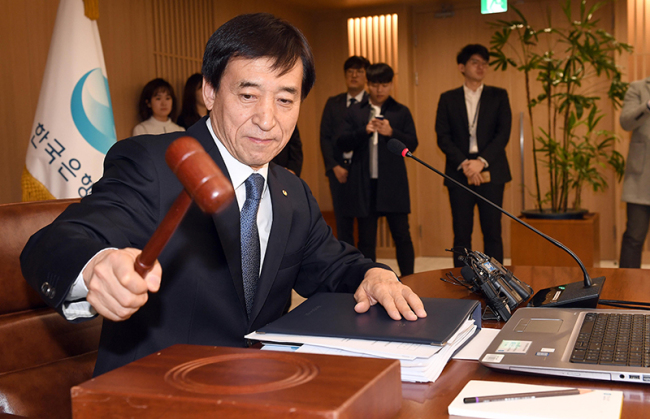South Korea's central bank on Thursday held its policy rate untouched for October on worsening economic data and low inflation pressure.
The monetary policy board of the Bank of Korea voted to freeze the policy rate at 1.5 percent for the 11th straight month.
The BOK has taken a wait-and-see stance since November last year, when it adjusted up the key rate for the first time in more than six years, citing the economic recovery.
Gov. Lee said two members of the seven-member board voted against the rate-freeing decision.
"Lee Il-houng and Koh Seung-beom called for a 0.25 percentage point increase," Lee said in a press briefing.
Lee has been hawkish for several months, saying that a rate increase is necessary to put mounting household credit under control.
Also, the monetary policy board slashed its earlier growth forecast by 0.2 percentage point to 2.7 percent for 2018, and marked down next year's growth to 2.7 percent.
The central bank took a more cautious step in October due to recent poorer-than-expected economic data.
 |
(Yonhap) |
"Going forward, the board expects domestic economic growth to be somewhat below the path projected in July, but to sustain a rate that does not diverge significantly from its potential level," the BOK said in a release. "The board will maintain its accommodative monetary policy stance."
The bank forecast 2.9 percent growth for 2018, down 0.1 percentage point from its earlier outlook.
Facility investment dropped for six months in a row, marking the longest monthly decline since the 1997 Asian financial crisis.
Employment was one of the worst economic indicators. The number of newly added jobs stayed below 10,000 on-month for two straight months in July and August, fueling concerns that the economy is losing steam.
Consumer prices have still stayed below the target inflation of 2 percent for months, despite a recent upside trend sparked by an oil price hike.
The BOK said prices will hover in the mid-1 to 2 percent range in coming months, but inflationary pressure on the demand side will remain weak for a while due to an economic downturn.
Moreover, escalating uncertainties over lingering trade rows between the United States and China also weighed heavily on Asia's fourth-largest economy. The world's two largest economies are South Korea's No. 1 and No. 2 trade partners.
"We see that such external risks seemed to surface and escalate rapidly. We face far higher uncertainties," Lee said. "We decided to wait and see further in a way to check the effect of the increased external uncertainties on the South Korean economy, inflation and the financial market."
With the rate freeze in October, many watchers said the BOK will make an adjustment in the coming rate-setting meeting slated for Nov. 30.
"In this process, (the board) will judge whether it is necessary to adjust its accommodative monetary policy, while closely checking future economic growth and inflation trends," the BOK statement continued.
The central bank's tone became stronger to some extent, as the word "carefully" was removed from the statement on the monetary policy decision for October for the first time in a year.
Gov. Lee has continuously given hints at a rate increase at least once in 2018, citing financial imbalance caused by a decade of low interest rates.
South Korea's household credit reached a record high of nearly 1,500 trillion won ($1.33 trillion) as of the end of June.
Also, the government has explicitly called for a higher interest rate as a means to cool down the overheated housing market. The affluent floating money has been blamed for pushing up apartment prices.
The central bank has to take the widening rate difference between South Korea and the US into account in the remaining months of 2018.
If the US Fed lifts its fund rate in December as planned, the Korea-US rate gap will reach as much as 1 percentage point.
A widening rate spread could spark an outflow of foreign investment from South Korea, where foreigners hold more than 30 percent of all stocks in the market. (Yonhap)




![[Weekender] Korea's traditional sauce culture gains global recognition](http://res.heraldm.com/phpwas/restmb_idxmake.php?idx=644&simg=/content/image/2024/11/21/20241121050153_0.jpg)



